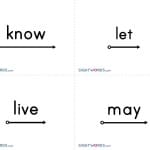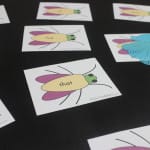Multisensory Teaching Techniques for Sight Words
Posted by Brainspring on 16th Jul 2015
Sight Words, Red Words, Popcorn Words, they go by many names but all teachers and students are familiar with non-phonetic words, those pesky words that don’t follow the usual phonics rules.
Where do you get your non-phonetic word lists from?
Today we have a guest post from Margo at SightWords. com, a free resource for teaching and practicing sight words. Many of the activities and games can be used to reinforce Red Words from Phonics First as well!
Sight words are an important supplement to phonics instruction. The ability to recognize these high frequency words “by sight,” rather than stopping to sound them out phonetically, builds fluency and speed in reading. This allows young students to progress sooner from “learning to read” to “reading to learn.”
Most elementary schools use one of two sight words lists in their classrooms. The Dolch list consists of 315 words that are the most frequently occurring words in children’s literature. The Fry list includes the 1,000 most common words in reading material for Grades 3-9.
 At SightWords.com, we recommend introducing new sight words to students through a series of classroom-tested and research-validated techniques based on the Orton-Gillingham method of multisensory teaching. Our five teaching techniques provide numerous repetitions of the sight word in a variety of forms—seeing the word, hearing the word, saying the word, reading the word, spelling the word, and writing the word. Just print out some sight words flash cards and get started:
At SightWords.com, we recommend introducing new sight words to students through a series of classroom-tested and research-validated techniques based on the Orton-Gillingham method of multisensory teaching. Our five teaching techniques provide numerous repetitions of the sight word in a variety of forms—seeing the word, hearing the word, saying the word, reading the word, spelling the word, and writing the word. Just print out some sight words flash cards and get started:
- See & Say: The child sees the word on the flash card and says the word.
- Spell Reading: The child says the word and spells out the letters, then reads the word again.
- Arm Tapping: The child says the word and then spells out the letters while tapping them on his/her arm, the reads the word again.
- Air Writing: The child says the word, writes the letters in the air in front of the flash card, then says the word again.
- Table Writing: The child writes the letters on the table, first looking at the flash card and then not looking at the flash card.
By engaging multiple of the child’s senses, you greatly increase the odds of getting the word into the student’s long-term memory. Visual, auditory, and kinesthetic feedback work together to reinforce the knowledge of each new word. Our website spells out exactly how to conduct each aspect of the sight words lesson, including video demonstrations. It actually goes very quickly: in just ten minutes you can introduce and go through all the teaching techniques for three to five new words.
 Reinforce your instruction with twenty minutes of one of our twelve sight words games. The games range from Bingo to Snakes & Ladders to suit a variety of needs and preferences. Book Land (our sight words version of Candy Land) can be played with younger siblings who aren’t reading yet. Dominoes uses just ten words, for when your child needs to spend extra time on a few tricky words. And Fly Swat is a favorite for letting kids move around as they “swat” the sight words. The games and flash cards are all fully customizable, so you can add in your own vocabulary words, even names!
Reinforce your instruction with twenty minutes of one of our twelve sight words games. The games range from Bingo to Snakes & Ladders to suit a variety of needs and preferences. Book Land (our sight words version of Candy Land) can be played with younger siblings who aren’t reading yet. Dominoes uses just ten words, for when your child needs to spend extra time on a few tricky words. And Fly Swat is a favorite for letting kids move around as they “swat” the sight words. The games and flash cards are all fully customizable, so you can add in your own vocabulary words, even names!
All parents and teachers of young children really need to check out SightWords.com. The site is designed for Pre-K to 4th-grade learners, and all the material is FREE. Our goal is to make your job easier, so that instead of scrambling to find educational materials, you can focus on teaching these precious children how to read!
Margo Edwards is the Director of Content Development at SightWords.com, a website dedicated to the promotion of child literacy through a variety of free online resources. SightWords.com is proud to be sponsored by the Georgia Preschool Association.
What other things do your students enjoy to learn and practice non-phonetic words?
Remember to like us on FB, follow us on Twitter and LinkedIn and share us with your friends!

